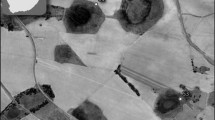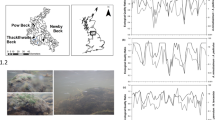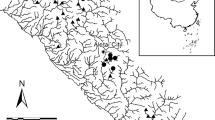Abstract
We assessed how diatom metrics were related to different ranges of agricultural land use. Diatom assemblage composition, nutrients, and landscape characteristics were determined at 232 sites in eight agriculturally dominated study areas of the continental United States. Two regional groups based on differences in diatom relations to human disturbance were determined. Changes in diatom species composition were related to nutrients, pH, and conductivity in the eastern study areas (due to more wetlands) and more exclusively to nutrients in the west-central study areas. Homogenization of diatom flora among streams was related to high agricultural disturbance at this transcontinental scale. Species traits were developed separately for the east and west-central study groups and calculated two ways: indicator species analysis for taxa in low and high TN or TP conditions and weighted average partial least squares models of TN and TP concentration. These diatom metrics were significantly related to many indicators of agricultural land use in watersheds, especially percent row crops. Further analysis was conducted on only the west-central region due to its larger sample size. Overall, diatom metrics using species responses to N gradients were better related to agricultural land use than were species responses to P gradients. Most nutrient-based diatom metrics changed greatly in response to low ranges of percent row crops, but only a few high N diatom metrics responded to high row crop conditions. The greater response of diatoms to changes in low agriculture conditions may be due to past diatom evolution occurring when most waters had low nutrient conditions.




Similar content being viewed by others
References
Black, R. W., Moran, P. W., & Frankforter, J. D. (2011). Response of algal metrics to nutrients and physical factors and identification of nutrient thresholds in agricultural streams. Environmental Monitoring and Assessment, 175(1–4), 397–417.
Bothwell, M. L. (1989). Phosphorus-limited growth dynamics of lotic periphytic diatom communities: Areal biomass and cellular growth rate responses. Canadian Journal of Fisheries and Aquatic Sciences, 46(8), 1293–1301.
Brightbill, R.A., and Munn, M.D. (2008). Environmental and biological data of the nutrient enrichment effects on stream ecosystems project of the National Water Quality Assessment Program, 2003–04: U.S. Geological Survey Data Series 345, 13 p. https://pubs.usgs.gov/ds/345/.
Brightbill, R.A., and Frankforter, J.D. (2010). Environmental and biological data for assessment of the nutrient enrichment effects on agricultural stream ecosystems, 2006–08—A project of the National Water-Quality Assessment Program: U.S. Geological Survey Data Series 517, 12 p., https://pubs.usgs.gov/ds/517/.
Carpenter, S. R., Caraco, N. F., Correll, D. L., Howarth, R. W., Sharpley, A. N., & Smith, V. H. (1998). Nonpoint pollution of surface waters with phosphorus and nitrogen. Ecological Applications, 8(3), 559–568.
Charles, D. F., Knowles, C., & Davies, R. S. (Eds.). (2002). Protocols for the analysis of algal samples collected as part of the U.S. Geological Survey National Water-Quality Assessment Program (pp. 02–06). Philadelphia: The Academy of Natural Sciences Report.
Charles, D. F., Acker, F. W., Hart, D. D., Reimer, C. W., & Cotter, P. B. (2006). Large-scale regional variation in diatom-water chemistry relationships: Rivers of the eastern United States. Hydrobiologia, 561(1), 27–57.
Davies, S. P., & Jackson, S. K. (2006). The biological condition gradient: A descriptive model for interpreting change in aquatic ecosystems. Ecological Applications, 16(4), 1251–1266.
Dodds, W. K., Clements, W. H., Gido, K., Hilderbrand, R. H., King, R. S., & R. S. (2010). Thresholds, breakpoints, and nonlinearity in freshwaters as related to management. Journal of the North American Benthological Society, 29(3), 988–997.
Dodds, W. K., & Oakes, R. M. (2004). A technique for establishing reference nutrient concentrations across watersheds affected by humans. Limnology and Oceanography: Methods, 2, 331–341.
Dodds, W. K., Smith, V. H., & Zander, B. (1997). Developing nutrient targets to control benthic chlorophyll levels in streams: A case study of the Clark Fork River. Water Resources, 31(7), 1738–1750.
Donohue, I., Jackson, A. L., Pusch, M. T., & Irvine, K. (2009). Nutrient enrichment homogenized lake benthic assemblages at local and regional scales. Ecology, 90(12), 3470–3477.
Dudley, T. L., Cooper, S. D., & Hemphill, N. (1986). Effects of macroalgae on a stream invertebrate community. Journal of the North American Benthological Society, 5(2), 93–106.
Dufrene, M., & Legendre, P. (1997). Species assemblages and indicator species: The need for a flexible asymmetrical approach. Ecological Monographs, 67(3), 345–366.
Fishman, M. J., (1993). Methods of analysis by the U.S. Geological Survey National Water Quality Laboratory-Determination of inorganic and organic constituents in water and fluvial sediments. U.S. Geological Survey Open-File Report 93–125.
Fitzpatrick, F. A., Waite, I. R., D’Arconte, P. J., Meador, M. R., Maupin, M. A., & Gurtz, M. E. (1998). Revised methods for characterizing stream habitat in the National Water-Quality Assessment Program: U.W. Geological Survey Water-Resources Investigations Report 98-052.
Francoeur, S. N. (2001). Meta-analysis of lotic nutrient amendment experiments: Detecting and quantifying subtle responses. Journal of the North American Benthological Society, 20(3), 358–368.
Fuhrer, G. J., Gilliom, R.J., Hamilton, P. A., Morace, J. L., Nowell, L. H., J. F. Rinella, et al. (1999). The quality of our nation’s water: Nutrients and pesticides. U.S. Geological Survey Circular 1225.
Hausmann, S., Charles, D. F., Gerritsen, J., & Belton, T. J. (2017). A diatom-based biological condition gradient (BCG) approach for assessing impairment and developing nutrient criteria for streams. Science of the Total Environment, 562, 914–927.
Johnson, L. B., Richards, C., Host, G. E., & Arthur, J. W. (1997). Landscape influences on water chemistry in Midwestern stream ecosystems. Freshwater Biology, 37, 193–208.
Johnson, M. R., & R. B. Zelt (2005). Protocols for mapping and characterizing land use/landcover in riparian zones. U.S. Geological Survey Open-File Report 2005–1302. https://pubs.usgs.gov/of/2005/1302/pdf/ofr2005-1302.pdf. Accessed 16 May 2018.
Juggins, S. (2007). C2 Version 1.5 User Guide. Software for ecological and paleological data analysis and visualization. Newcastle upon Tyne: Newcastle University.
Kelly, M. G., & Whitton, B. A. (1995). The trophic diatom index: A new index for monitoring eutrophication in rivers. Journal of Applied Phycology, 7(4), 433–444.
Kelly, M. G., Bennion, H., Cox, E. J., Goldsmith, B., Jamieson, J., Juggins, S., et al. (2005). Common freshwater diatoms of Britain and Ireland: An interactive key. Bristol: Environment Agency.
Leps, J., & Smilauer, P. (2003). Multivariate analysis of ecological data using CANOCO. Cambridge: Cambridge University Press.
Lougheed, V. L., McIntosh, M. D., Parker, C. A., & Stevenson, R. J. (2008). Wetland degradation leads to homogenization of biota at local and landscape scales. Freshwater Biolog, 53(12), 2402–2413.
Manoylov, K. M., & Stevenson, R. J. (2006). Density-dependent algal growth along N and P nutrient gradients in artificial streams. In N. Ognjanova-Rumenova & K. Manoylov (Eds.), Advances in phycological studies (pp. 333–352). Moscow: Pensoft Publishers.
McCune, R., & Mefford, M. J. (2006). PC-ORD. multivariate analysis of ecological data. Version 5.10. Gleneden Beach: MjM Software.
Millennium Ecosystem Assessment (M A). (2003). Ecosystems and human well-being: A framework for assessment. Washington, DC: Island Press.
Miltner, R. J., & Rankin, E. T. (1998). Primary nutrients and the biotic integrity of rivers and streams. Freshwater Biology, 40, 145–153.
Moulton II, S. R., Kennen, J. G., Goldstein, R. M., & Hambrook, J. A. (2002). Revised protocols for sampling algal, invertebrate, and fish communities as part of the National Water Quality Assessment Program. U.S. Geological Survey Open-File Report 02–150.
Munn, M. D., Frey, J., & Tesoriero, A. (2010). The influence of nutrients and physical habitat in regulating algal biomass in agricultural streams. Environmental Management, 45(3), 603–615.
Nakagaki, N., & Wolock, D.M. (2005). Estimation of agricultural pesticide use in drainage basins using land cover maps and county pesticide data. U.S. Geological Survey Open-File Report 2005–1188.
Osborne, L. L., & Wiley, M. J. (1988). Empirical relationships between land use/cover and stream water quality in an agricultural watershed. Journal of Environmental Management., 26, 9–27.
Pan, Y., Stevenson, R. J., Hill, B. H., Herlihy, A. T., & Collins, G. B. (1996). Using diatoms as indicators of ecological conditions in lotic systems: A regional assessment. Journal of the North American Benthological Society, 15(4), 481–495.
Patton, C. J., & Kryskalla, J. R. (2003). Methods of analysis by the U.S. Geological Survey National Water Quality Laboratory—Evaluation of alkaline persulfate digestion as an alternative to Kjeldahl digestion for determination of total and dissolved nitrogen and phosphorus in water. U.S. Geological Survey Water-Resources Investigations Report. 03–4174.
Patton, C. J., & Truitt, E. P. (2000). Methods of analysis by the U.S. Geological Survey National Water Quality Laboratory-Determination of ammonium plus organic nitrogen by a Kjeldahl digestion method and an automated photometric finish that includes digest cleanup by gas diffusion. U.S. Geological Survey Open-File Report 00–170.
Ponander, K. C., Charles, D. F., & Belton, T. J. (2007). Diatom based TP and TN inference models and indices for monitoring nutrient enrichment of New Jersey streams. Ecological Indicators, 7(1), 79–93.
Potapova, M. G., & Charles, D. F. (2007). Diatom metrics for monitoring eutrophication in rivers of the United States. Ecological Indicators, 7(1), 48–70.
Potapova, M. G., Charles, D. F., Ponader, K. C., & Winter, D. M. (2004). Quantifying species indicator values for trophic diatom indices: A comparison of approaches. Hydrobiologia, 517, 25–41.
Rier, S. T., & Stevenson, R. J. (2006). Response of periphytic algae to gradients in nitrogen and phosphorus in streamside mesocosms. Hydrobiologia, 561(1), 131–147.
Ruddy, B. C., Lorenz, D. L., & Mueller, D. K. (2006). County-level estimates of nutrients inputs in the land surface of the conterminous United States, 1982–2001. U.S. Geological Survey Scientific Investigations Report. 2006–5012.
Sabater, S., Guasch, H., Romani, A., & Munoz, I. (2000). Stromatolitic communities in Mediterranean streams: Adaptations to a changing environment. Biodiversity and Conservation, 9, 379–392.
Schneider, S. C., Kahlert, M., & Kelly, M. G. (2013). Interactions between pH and nutrients on benthic algae in streams and consequences for ecological status assessment and species richness patterns. Science of the Total Environment, 444, 73–84.
Schindler, D. W. (2006). Recent advances in the understanding and management of eutrophication. Limnology and Oceanography, 51(1, part 2), 356–363.
Sharpley, A. N., Herron, S., & Daniel, T. (2007). Overcoming the challenges of phosphorus based management in poultry farming. Journal of Soil and Water Conservation, 62(6), 375–389.
Sharpley, A., Jarvie, H. P., Buda, A., May, L., Spears, B., & Kleinman, P. (2013). Phosphorus legacy: Overcoming the effects of past management practices to mitigate future water quality management. Journal of Environmental Quality, 42(5), 1308–1326.
Shelton, L. R. (1994). Field guide for collecting and processing stream-water samples for the National Water-Quality Assessment Program. U.S. Geological Survey Open-File Report 94–455.
Smith, V. H., Tilman, G. D., & Nekola, J. C. (1999). Eutrophication: Impacts of excess nutrient inputs on freshwater, marine, and terrestrial ecosystems. Environmental Pollution, 100(1–3), 179–196.
Smucker, N. J., Becker, M., Detenbeck, N. E., & Morrison, A. C. (2013). Using algal metrics and biomass to evaluate multiple ways of defining concentration-based nutrient criteria in streams and their ecological relevance. Ecological Indicators, 32, 51–61.
Stevenson, R. J. (1997). Scale-dependent determinants and consequences of benthic algal heterogeneity. Journal of the North American Benthological Society, 16(1), 248–262.
Stevenson, R. J. (2006). Refining diatom indicators for valued ecological attributes and development of water quality criteria. In N. Ognjanova-Rumenova & K. Manoylov (Eds.), Advances in phycological studies (pp. 365–383). Moscow: Pensoft Publishers.
Stevenson, R. J. (2014). Ecological assessment with algae: A review and synthesis. Journal of Phycology, 50(3), 437–461.
Stevenson, R. J., Bailey, R. C., Harass, M. C., Hawkins, C. P., Alba-Tercedor, J., Couch, C., et al. (2004). Designing data collection for ecological assessments. In M. T. Barbour, S. B. Norton, H. R. Preston, & K. W. Thornton (Eds.), Ecological assessment of aquatic resources: Linking science to decision-making (pp. 55–84). Pensacola, Florida: Society of Environmental Toxicology and Contamination Publication.
Stevenson, R. J., Rier, S. T., Riseng, C. M., Schultz, R. E., Wiley, M. J. (2006). Comparing effects of nutrients on algal biomass in streams in two regions with different disturbance regimes and with applications for developing nutrient criteria. Hydrobiologia, 561(1), 149–165.
Stevenson, R. J., Bennett, B. J., Jordan, D. N., & French, R. D. (2012). Phosphorus regulates stream injury by filamentous green algae, thresholds, DO, and pH. Hydrobiologia, 695(1), 25–42.
Stevenson, R. J., Hill, B. H., Herlihy, A. T., Yuan, L. L., & Norton, S. B. (2008a). Algae-P relationships, thresholds, and frequency distributions guide nutrient criterion development. Journal of the North American Benthological Society, 27(3), 783–799.
Stevenson, R. J., Pan, Y., Manoylov, K. M., Parker, C. A., Larson, D. P., & Herlihy, A. T. (2008b). Development of diatom indicators of ecological conditions for streams of the western US. Journal of the North American Benthological Society, 27(4), 1000–1016.
Suplee, M. W., Watson, V., Teply, M., & McKee, H. (2008). How green is too green? Public opinion of what constitutes undesirable algae levels in streams. Journal-American Water Works Association, 44(1), 1–18.
ter Braak, C. J. F., & Juggins, S. (1993). Weighted averaging partial least squares regression (WA-PLS): An improved method for reconstructing environmental variables from species assemblages. Hydrobiologia, 269(270), 485–502.
ter Braak, C. J. F., & Smilauer, P. (2002). CANOCO reference manual and CanoDraw for Windows User’s guide: Software for Canonical Community Ordination (version 4.5). Ithaca: Microcomputer Power.
U.S. Environmental Protection Agency (USEPA). (2000). Stressor identification guidance document. EPA-822-B-00-025. Washington, DC: United States Environmental Protection Agency.
U.S. Environmental Protection Agency (USEPA). (2007). National Water Quality Inventory: Report to Congress. 2002 Reporting Cycle. EPA 841-R-07-001. Washington: United States Environmental Protection Agency.
U.S. Environmental Protection Agency (USEPA). (2009). National lakes assessment: A collaborative survey of the nation’s lakes. EPA 841-R-09-001. Washington, D.C.: U.S. Environmental Protection Agency, Office of Water and Office of Research and Development.
U.S. Environmental Protection Agency (USEPA). (2013). National rivers and streams assessment 2008–2009: A collaborative survey-draft report. United States Environmental Protection Agency: Washington D.C.
U.S. Geological Survey and U.S. Environmental Protection Agency (2003). National Hydrography Dataset (NHD): U.S. Geological survey [digital data]. http://nhd.usgs.gov. accessed June 2003.
van Dam, H., Mertenes, A., & Sinkeldam, J. (1994). A coded checklist and ecological indicator values of freshwater diatoms from the Netherlands. Aquatic Ecology, 28(1), 117–133.
Vogelmann, J. E., Howard, S. M., Yang, L., Larson, C. R., Wylie, B. K., & Van Driel, N. (2001). Completion of the 1990’s national land cover dataset for the conterminous United States from Landsat thematic mapper data and ancillary data sources. Photogrammetric Engineering and Remote Sensing, 67(6), 650–662.
Wang, L., Robertson, D. M., & Garrison, P. L. (2007). Linkages between nutrients and assemblages of macro-invertebrates and fish in wadeable streams: Implication to nutrient criteria development. Environmental Management, 30, 194–212.
Wang, Y. K., Stevenson, R. J., & Metzmeier, L. (2005). Development and evaluation of a diatom-based index of biotic integrity for the Interior Plateau Ecoregion. Journal of the North American Benthological Society, 24(4), 990–1008.
Wolock, D.M. (2003). Base-flow index for the United States: U.S. Geological Survey Open-File Report 03–263, [digital data]. http://water.usgs.gov.lookup/getspatial?bfi48grd. accessed September 2005.
Wu, N., Dong, X., Liu, Y., Wang, C., Baattrup-Pedersen, A., & Riis, T. (2017). Using river microalgae as indicators for freshwater biomonitoring: Review of published research and future directions. Ecological Indicators, 81, 124–131.
Acknowledgements
This study could not have been done without the data collection efforts of Robert Black, Daniel Calhoun, Brian Caskey, Jill Frankforter, Brian Gregory, Patrick Moran, and Holly Weyers. The authors would like to also thank Kurt Carpenter and Sarah Spaulding for technical review, along with journal reviewers. This study was funded as part of the U.S. Geological Survey’s National Water Quality Assessment Program, Nutrient Effects on Stream Ecosystems (http://wa.water.usgs.gov/neet/).
Author information
Authors and Affiliations
Corresponding author
Additional information
Publisher’s note
Springer Nature remains neutral with regard to jurisdictional claims in published maps and institutional affiliations.
Electronic supplementary material
ESM 1
(DOCX 76 kb)
Appendix
Appendix
Rights and permissions
About this article
Cite this article
Pillsbury, R., Stevenson, R.J., Munn, M.D. et al. Relationships between diatom metrics based on species nutrient traits and agricultural land use. Environ Monit Assess 191, 228 (2019). https://doi.org/10.1007/s10661-019-7357-8
Received:
Accepted:
Published:
DOI: https://doi.org/10.1007/s10661-019-7357-8




